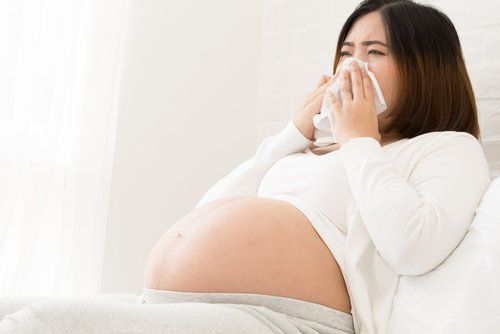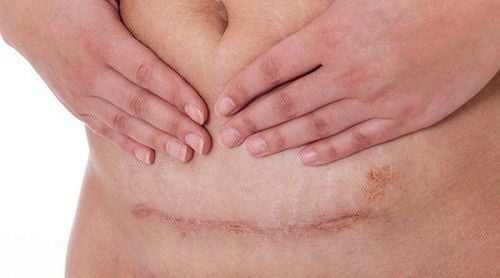This is an automatically translated article.
The article is professionally consulted by Specialist Doctor II Tran Thi Mai Huong - Department of Obstetrics and Gynecology - Vinmec Hai Phong International General Hospital.
1. Should caesarean section be horizontal or vertical?
A cesarean section is a surgical procedure that removes the fetus, placenta, and amniotic membrane from the abdomen by making an incision through the abdominal wall and the uterine wall is intact.Caesarean section is a major abdominal surgery, with a higher risk of complications than vaginal delivery. One of the common clinical complications such as bleeding after cesarean section, pain after cesarean section, wound infection, infection of the uterus and abdomen,...and takes a long time to recover.
Cesarean section has two methods: horizontal and vertical.
Transverse caesarean section:
Is a caesarean section where the incision is 10-12cm long, located on the scapula, right at the inner hem of the pants. Advantages: beautiful surgical scars. quick immediately. Cons: Takes longer and has a higher risk of bleeding than vertical surgery

Is a caesarean section in which the incision is determined from the position below the navel to the pubic area (running along the middle white line below the navel). The long incision goes through the layers of skin. fat, abdominal muscles to the uterus. Advantages: this method allows to perform quickly, takes less time, is convenient, suitable for emergency caesarean section such as uterine rupture, ectopic pregnancy with a lot of blood loss or cases of severe loss of blood. postpartum blood. With this method of caesarean section, if during the cesarean section there is a need to widen the incision, this method can be done. Cons: Compared with horizontal incisions, vertical incisions are often not beautiful, more prone to leaving keloid scars. Both vertical and horizontal surgery methods, each method has its own advantages and disadvantages, suitable for each situation as well as the health status of the mother and fetus during labor. In clinical practice, up to 90% of caesarean sections are performed by transverse incision because the horizontal incision heals quickly, is aesthetically pleasing, and has fewer complications than the vertical incision. In fact, the choice of method will be chosen by the doctor performing the surgery based on the actual situation of both mother and child to achieve the ultimate goal of safely removing the fetus from the abdomen. without affecting the mother's health, while minimizing complications during and after surgery.

2. When is the caesarean section?
Caesarean section is a really necessary method in obstetrics. However, compared with vaginal delivery, cesarean section carries a higher risk of complications. On the other hand, in the normal delivery method, the recovery of the mother's health and the development of the baby after birth has many advantages compared to the cesarean section.Therefore, in clinical practice, if not really necessary, vaginal delivery is the first choice method. In some cases, the initial method of vaginal delivery is chosen, but due to abnormalities in labor, it is necessary to switch to a cesarean section. The question is, in what cases is a caesarean section indicated?
Indications for caesarean section:
Before labor:
There is a history of previous caesarean section. Abnormal pregnancy such as inverted, horizontal... Cases of multiple pregnancy, twin pregnancy. The fetus has abnormal problems, the mother is suffering from some diseases in the genital area that can infect the baby such as genital herpes caused by herpes, syphilis, gonorrhea, genital warts, inflammation genital infection... The mother has placenta previa or placental abruption. A mother with preeclampsia puts herself and her unborn baby at risk during labor.

There are abnormalities in fetal health during labor: fetal failure, Cases of umbilical cord or colon prolapse Flowers wrapped around the neck affect the baby's breathing and hinder the progress of the birth. Premature placental abruption or sudden placental abruption. Caesarean section is a major abdominal surgery that can leave many risks of complications after birth for the mother if the safety principles of the surgery are not followed properly. Not all cases when signs of labor are indicated for caesarean section. Horizontal caesarean section or vertical caesarean section depends on each case.
Vinmec International General Hospital offers a Package Maternity Care Program for pregnant women right from the first months of pregnancy with a full range of antenatal care visits, periodical 3D and 4D ultrasounds and routine tests to ensure that the mother is healthy and the fetus is developing comprehensively. Pregnant women will be consulted and checked for health under the close supervision of experienced and specialized obstetricians, helping mothers gain more knowledge to protect their health during pregnancy as well as minimize complications affecting mother and child.
Doctor Tran Thi Mai Huong has 25 years of experience in examination and treatment in the field of Obstetrics and Gynecology, lower tract surgery, laparoscopic surgery. Has held the position of deputy head of the School of Obstetrics and Gynecology, deputy head of the delivery department - Hai Phong Obstetrics and Gynecology Hospital. Has high expertise and strength in the field of:
Lower tract surgery Laparoscopic surgery Difficult obstetric surgery
Please dial HOTLINE for more information or register for an appointment HERE. Download MyVinmec app to make appointments faster and to manage your bookings easily.














